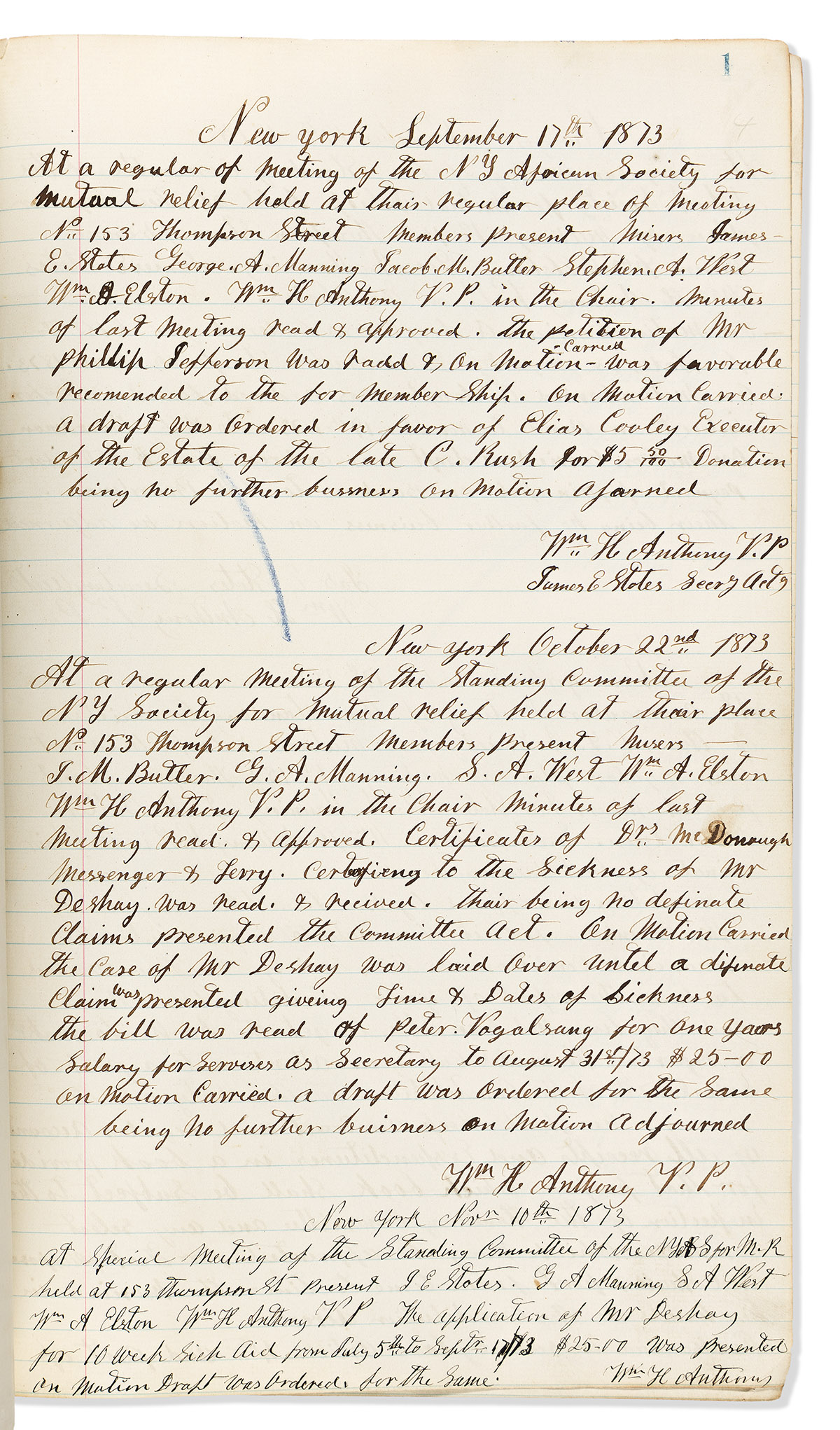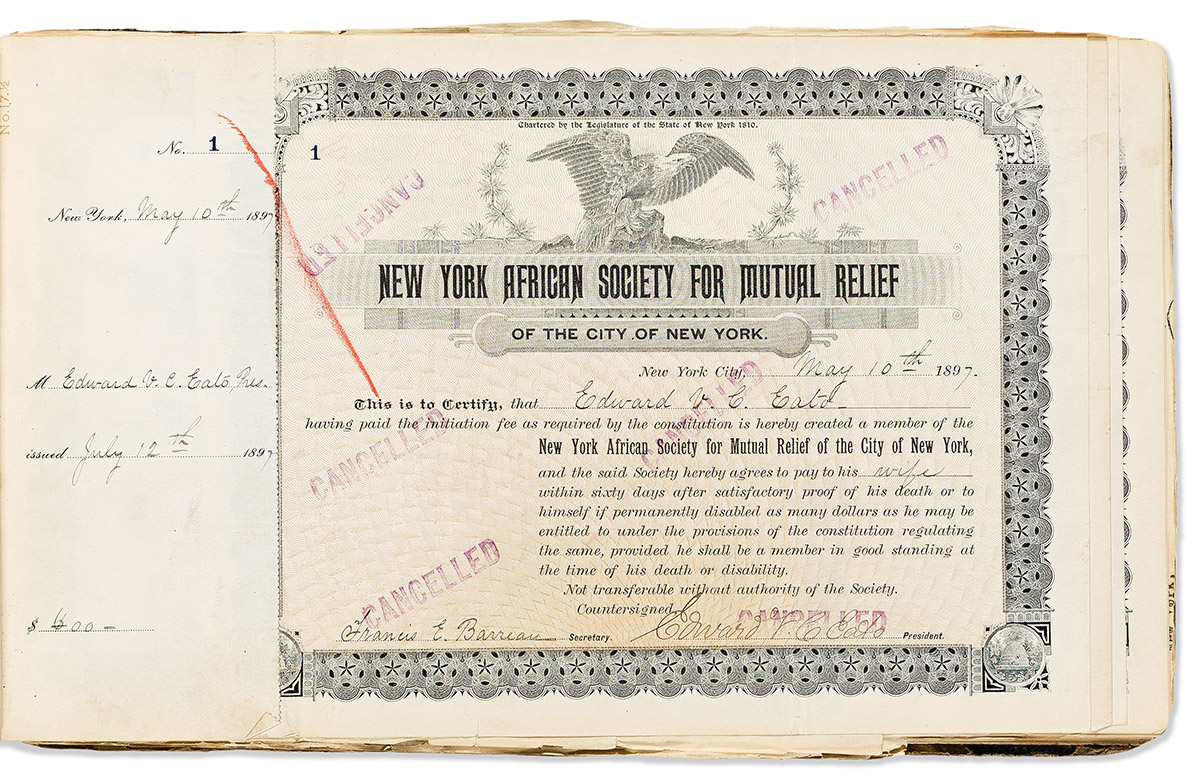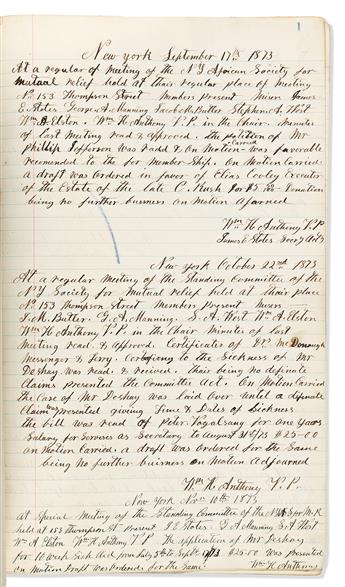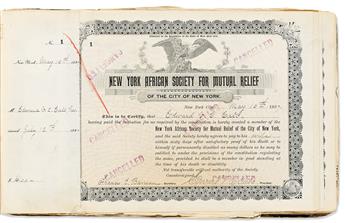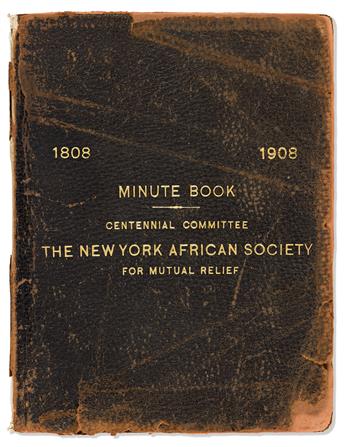Sale 2663 - Lot 241
Price Realized: $ 9,500
Price Realized: $ 11,875
?Final Price Realized includes Buyer’s Premium added to Hammer Price
Estimate: $ 4,000 - $ 6,000
(FRATERNAL.) Record books of the New York African Society for Mutual Relief. 3 manuscript volumes, various bindings, each about 12 x 8 inches, generally worn, one board detached, the outer sheep covering of the Centennial Committee wrappers worn and coming detached; generally minor wear to contents, a few apparently blank leaves torn out. New York, 1873-1916
Additional Details
The New York African Society for Mutual Relief was one of the nation's first benefit societies for African-Americans. They generated income through dues and through rent on property owned by the Society, and paid out benefits to members who died or became unable to work. The Society was formally established in 1808 and incorporated in 1810. They faced mob violence in the anti-abolitionist riots of 1834, but by the end of the Civil War had become a financially stable organization. Their demise sprang from the arrival of New Deal social services which supplanted the Society's safety net; they began to unwind operations in 1945. Offered here are:
Minute book of the Standing Committee, 17 September 1873 to 28 January 1886. 69, [4] manuscript pages. The committee discussed individual applications for membership, and requests from the membership for relief. For example, on 30 October 1878, they discussed applicant "E.C. Johnson, residing 182 Thompson St., porter, aged 42 years old. Mr. May testified to the good character of the candidate and believed him to be not over the age specified in the rule." They decided that Johnson was "a fit person to be admitted into the society." A few reports from the Banking Committee are recorded which show the Society's finances. In September 1879 they showed a starting balance of $1688.14, $1200 received in rent, $103.30 in dues received, $81.32 in interest, and a closing balance of $2125.92. When a member requested payment on a sick claim, a committee was dispatched to their home. On 27 September 1882, one member was found "confined to the house with a very bad limb, erysipelas and dropsical tendency, disabling him from attending to his business," and they recommended two weeks of aid. He eventually was granted the upper limit of "all that is due him from the society," and his funeral expenses were authorized on 7 May 1883. On 18 October 1882, they debated the sale of a property on Baxter Street, said to be "very old, needs constantly repairing." At the rear of the volume is a 4-page list of checks issued by the Society.
Minute book of the Centennial Committee, 8 March 1907 to 18 June 1908. 25 manuscript pages plus 6 pieces of ephemera laid down. Documents the planning for the 100th anniversary of the society's June 1808 founding. Committees were formed to secure Carnegie Hall, to get noted lawyer D. Macon Webster to give an historical address, to provide a banquet and music. Booker T. Washington is named as a guest speaker on 7 May 1908. The committee's bills were settled in the final 18 June 1908 entry. Laid in are the Committee on Printing's mockup of a draft menu, an invitation and ticket, the printed church service program and banquet menu, and a 13 June telegram from Booker T. Washington: "My extreme regret cannot be present on occasion. . . . I have followed course this society with deep interest and encouragement for number of years. . . . They have set an example which race should follow." Only one other example of the 12-page church program appears in OCLC, at the New York Public Library; the elegant "Centennial Banquet" menu naming speakers, officers and members is unrecorded.
Membership certificate book, 1897-1916. 85 membership certificate stubs naming the member and issuance date; 55 canceled membership certificates tipped in, and 12 blank certificates still attached to blank stubs. Apparently membership certificates were reissued in 1897, even to older members. Each is signed by society officers, bears its embossed seal, names the member's beneficiaries, and is variously marked, stamped or slashed when it was presented back to the society for the redemption of final death benefits. Many have manuscript receipts by the beneficiaries on verso. A few have notarized notes changing their beneficiaries.
Other records of the Society are held at the Brooklyn campus of Long Island University.
Minute book of the Standing Committee, 17 September 1873 to 28 January 1886. 69, [4] manuscript pages. The committee discussed individual applications for membership, and requests from the membership for relief. For example, on 30 October 1878, they discussed applicant "E.C. Johnson, residing 182 Thompson St., porter, aged 42 years old. Mr. May testified to the good character of the candidate and believed him to be not over the age specified in the rule." They decided that Johnson was "a fit person to be admitted into the society." A few reports from the Banking Committee are recorded which show the Society's finances. In September 1879 they showed a starting balance of $1688.14, $1200 received in rent, $103.30 in dues received, $81.32 in interest, and a closing balance of $2125.92. When a member requested payment on a sick claim, a committee was dispatched to their home. On 27 September 1882, one member was found "confined to the house with a very bad limb, erysipelas and dropsical tendency, disabling him from attending to his business," and they recommended two weeks of aid. He eventually was granted the upper limit of "all that is due him from the society," and his funeral expenses were authorized on 7 May 1883. On 18 October 1882, they debated the sale of a property on Baxter Street, said to be "very old, needs constantly repairing." At the rear of the volume is a 4-page list of checks issued by the Society.
Minute book of the Centennial Committee, 8 March 1907 to 18 June 1908. 25 manuscript pages plus 6 pieces of ephemera laid down. Documents the planning for the 100th anniversary of the society's June 1808 founding. Committees were formed to secure Carnegie Hall, to get noted lawyer D. Macon Webster to give an historical address, to provide a banquet and music. Booker T. Washington is named as a guest speaker on 7 May 1908. The committee's bills were settled in the final 18 June 1908 entry. Laid in are the Committee on Printing's mockup of a draft menu, an invitation and ticket, the printed church service program and banquet menu, and a 13 June telegram from Booker T. Washington: "My extreme regret cannot be present on occasion. . . . I have followed course this society with deep interest and encouragement for number of years. . . . They have set an example which race should follow." Only one other example of the 12-page church program appears in OCLC, at the New York Public Library; the elegant "Centennial Banquet" menu naming speakers, officers and members is unrecorded.
Membership certificate book, 1897-1916. 85 membership certificate stubs naming the member and issuance date; 55 canceled membership certificates tipped in, and 12 blank certificates still attached to blank stubs. Apparently membership certificates were reissued in 1897, even to older members. Each is signed by society officers, bears its embossed seal, names the member's beneficiaries, and is variously marked, stamped or slashed when it was presented back to the society for the redemption of final death benefits. Many have manuscript receipts by the beneficiaries on verso. A few have notarized notes changing their beneficiaries.
Other records of the Society are held at the Brooklyn campus of Long Island University.
Exhibition Hours
Exhibition Hours
Aliquam vulputate ornare congue. Vestibulum maximus, libero in placerat faucibus, risus nisl molestie massa, ut maximus metus lectus vel lorem.



